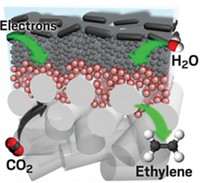Advertisement
Grab your lab coat. Let's get started
Welcome!
Welcome!
Create an account below to get 6 C&EN articles per month, receive newsletters and more - all free.
It seems this is your first time logging in online. Please enter the following information to continue.
As an ACS member you automatically get access to this site. All we need is few more details to create your reading experience.
Not you? Sign in with a different account.
Not you? Sign in with a different account.
ERROR 1
ERROR 1
ERROR 2
ERROR 2
ERROR 2
ERROR 2
ERROR 2
Password and Confirm password must match.
If you have an ACS member number, please enter it here so we can link this account to your membership. (optional)
ERROR 2
ACS values your privacy. By submitting your information, you are gaining access to C&EN and subscribing to our weekly newsletter. We use the information you provide to make your reading experience better, and we will never sell your data to third party members.
Energy
Solar Fuel, With High Efficiency
Renewable Energy: Continuous cerium oxide-based syngas generator suggests possible industrial use
by Stu Borman
January 3, 2011
| A version of this story appeared in
Volume 89, Issue 1

Researchers have developed a novel thermochemical reactor that uses sunlight to convert carbon dioxide and water into hydrocarbon-fuel precursors at a relatively high efficiency.
The feat is a key step toward using solar energy to produce much-needed liquid fuels more efficiently than may be possible with alternative methods, such as photocatalysis or microbial fermentation-based hydrocarbon-fuel production.
The new thermochemical reactor is believed to be more efficient than previously developed ones, whose efficiencies could not be comparably measured. And it is amenable to continuous operation, suggesting that an industrial-scale version of the process could be developed for solar towers.
The reactor was designed by solar technology specialist Aldo Steinfeld of ETH, the Swiss Federal Institute of Technology, Zurich; materials scientist Sossina M. Haile of California Institute of Technology; and coworkers (Science, DOI: 10.1126/science.1197834). It uses concentrated solar energy to thermochemically dissociate CO2 and H2O via cerium oxide redox reactions to produce CO and H2, respectively, with O2 as a by-product. CO and H2 form syngas, which can be processed to generate methanol, gasoline, and other liquid fuels.
The reactor’s solar-to-syngas energy conversion efficiency, experimentally measured with a 2-kW prototype, is 0.7 to 0.8%, which Steinfeld says is significantly higher than those of current photocatalytic methods for CO2 dissociation. A thermodynamic analysis indicates that efficiencies of 16% or more are achievable with the new reactor.
The study’s “solar conversion efficiencies are less than 1%, but these efficiencies set an important benchmark for further improvements in the use of pure solar thermal energy to split CO2,” notes renewable energy researcher Stuart Licht of George Washington University.
The novelty is the experiment’s relatively large scale, “the number of cycles demonstrated, and performing the demonstration long enough and in such a reproducible and controlled way that the efficiency can be carefully determined,” says thermochemistry specialist James E. Miller of Sandia National Laboratories. “It’s a step toward demonstrating what’s possible for a technology that has been underappreciated and deserves more attention.”





Join the conversation
Contact the reporter
Submit a Letter to the Editor for publication
Engage with us on Twitter